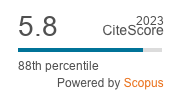Article | Open Access
Gen Z Sexual and Gender Fluidity in US Scripted Television
| Views: | 285 | | | Downloads: | 387 |
Abstract: This essay addresses the rise in sexual and gender-fluid characters in scripted US television targeting the Gen Z audience (born 1997–2012), based on their moniker as the “queerest” generation, with over 20% of younger US and international respondents identifying as LGBTQ in polls, the majority as sexually fluid (bi/pansexual) or non-binary (genderfluid/genderqueer). By analyzing six series (2019–2023) marketed as “authentically” Gen Z, I argue this shift invests in Gen Z’s “hip” attitude towards such fluidity the same way Caldwell argues that 1990’s diversification of the televisual audience produced a “programming agenda…that cultivates and rewards distinction in ethnic, racial, and class terms” (2020, p. 376). Caldwell’s (2020) theory of boutique programming, described as “a selective, signature world where artistic sensitivity went hand in hand with social relevance and viewer discrimination” (p. 164), exposes how these recent series rely on “visual flourishes…and narrative embellishments” (p. 377) but move beyond cinematic techniques by combining palatial settings and extravagant lifestyles with shockingly explicit sexual situations. Caldwell’s (2020, p. 377) assertion that “stardom and gossip defeat the dramatic obligation or need for narrative coherence” is reflected in the 21st century’s reliance on social media promotions with hypersexual imagery and expensive designer outfits for its high school-age characters and an entertainment media which highlights their “edgy,” “sexy,” “explicit,” and “provocative” content. Therefore, I argue that, like Caldwell, we should avoid “overestimat[ing] the political value” (2020, p. 376) of these presentations when these non-binary identities are shown as inaccessible, depoliticized, and hypersexualized, which maintains rather than challenges entrenched binary ideals of gender and sexuality.
Keywords: American television; bisexuality; gender non-binary; Gen Z; LGBTQ; television; televisuality; teen series
Published:
© Traci B. Abbott. This is an open access article distributed under the terms of the Creative Commons Attribution 4.0 license (http://creativecommons.org/licenses/by/4.0), which permits any use, distribution, and reproduction of the work without further permission provided the original author(s) and source are credited.




